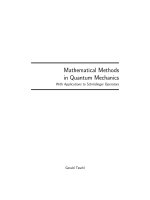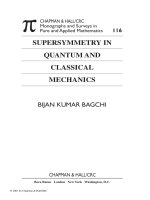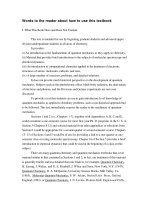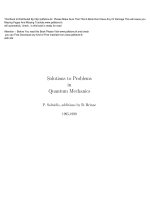- Trang chủ >>
- Khoa Học Tự Nhiên >>
- Vật lý
Supersymmetry in quantum mechanics
Bạn đang xem bản rút gọn của tài liệu. Xem và tải ngay bản đầy đủ của tài liệu tại đây (7.43 MB, 224 trang )
www.pdfgrip.com
www.pdfgrip.com
www.pdfgrip.com
Fred Cooper
Los Alamos National Laboratory
Avinash Khare
Institute of Physics, Bhubaneswar
Uday Sukhatme
University of Illinois, Chicago
World Scientific
Singapore New Jersey. London Hong Kong
www.pdfgrip.com
Published by
World Scientific Publishing Co. Re. Ltd.
P 0 Box 128, Farrer Road, Singapore 912805
USA office: Suite lB, 1060 Main Street, River Edge, NJ 07661
UK office: 57 Shelton Street, Covent Garden, London WC2H 9HE
British Library Cataloguing-in-PublicationData
A catalogue record for this book is available from the British Library.
SUPERSYMMETRY IN QUANTUM MECHANICS
Copyright 0 2001 by World ScientificPublishing Co. Re. Ltd.
All rights reserved. This book or parts thereof; may not be reproduced in any form or by any means,
electronic or mechanical, including photocopying, recording or any information storage and retrieval
system now known or to be invented, without written permissionfrom the Publisher.
For photocopying of material in this volume, please pay a copying fee through the Copyright
Clearance Center, Inc., 222 Rosewood Drive, Danvers, MA 01923, USA. In this case permission to
photocopy is not required from the publisher.
ISBN 981-02-4605-6
ISBN 981-02-4612-9 (pbk)
Printed in Singapore by UtePrint
www.pdfgrip.com
DEDICATED
TO OUR WIVES
CATHERINE,
PUSHPA
AND MEDHA.
www.pdfgrip.com
www.pdfgrip.com
Preface
During the past fifteen years, a new conceptual framework for understanding potential problems in quantum mechanics has been developed
using ideas borrowed from quantum field theory. The concept of supersymmetry when applied to quantum mechanics has led to a new way of relating
Hamiltonians with similar spectra. These ideas are simple enough to be a
part of the physics curriculum.
The aim of this book is to provide an elementary description of supersymmetric quantum mechanics which complements the traditional coverage found in existing quantum mechanics textbooks. In this spirit we give
problems at the end of each chapter as well as complete solutions to all the
problems. While planning this book, we realized that it was not possible to
cover all the recent developments in this field. We therefore decided that,
instead of pretending to be comprehensive, it was better to include those
topics which we consider important and which could be easily appreciated
by students in advanced undergraduate and beginning graduate quantum
mechanics courses.
It is a pleasure to thank all of our many collaborators who helped in
our understanding of supersymmetric quantum mechanics. This book could
not have been written without the love and support of our wives Catherine,
Pushpa and Medha.
Fred Cooper, Avinash Khare, Uday Sukhatme
Los Alamos, Bhubaneswar, Chicago
September 2000
vii
www.pdfgrip.com
www.pdfgrip.com
Contents
Preface
vii
Chapter 1 Introduction
1
Chapter 2 The Schrodinger Equation in One Dimension
2.1 General Properties of Bound States . . . . . . . . . . . . . . . .
2.2 General Properties of Continuum States and Scattering . . . .
2.3 The Harmonic Oscillator in the Operator Formalism . . . . . .
7
8
9
10
Chapter 3 Factorization of a General Hamiltonian
3.1 Broken Supersymmetry . . . . . . . . . . . . . . . . . . . . . .
3.2 SUSY Harmonic Oscillator . . . . . . . . . . . . . . . . . . . .
3.3 Factorization and the Hierarchy of Hamiltonians . . . . . . . .
15
23
28
30
Chapter 4 Shape Invariance and Solvable Potentials
35
4.1 General Formulas for Bound State Spectrum. Wave Functions
36
and S-Matrix . . . . . . . . . . . . . . . . . . . . . . . . . . . .
4.2 Strategies for Categorizing Shape Invariant Potentials . . . . . 38
4.2.1 Solutions Involving Translation . . . . . . . . . . . . . . 38
4.2.2 Solutions Involving Scaling . . . . . . . . . . . . . . . . 47
53
4.2.3 Other Solutions . . . . . . . . . . . . . . . . . . . . . . .
4.3 Shape Invariance and Noncentral Solvable Potentials . . . . . . 56
Chapter 6 Charged Particles in External Fields and Supersymmetry
61
5.1 Spinless Particles . . . . . . . . . . . . . . . . . . . . . . . . . .
61
ix
www.pdfgrip.com
X
Contents
Non-relativistic Electrons and the Pauli Equation . . . . . . . .
5.3 Relativistic Electrons and the Dirac Equation . . . . . . . . . .
5.2
5.4
5.5
5.6
5.7
62
68
SUSY and the Dirac Equation . . . . . . . . . . . . . . . . . . 70
Dirac Equation with a Lorentz Scalar Potential in 1+1Dimensions 72
Supersymmetry and the Dirac Particle in a Coulomb Field . . 75
SUSY and the Dirac Particle in a Magnetic Field . . . . . . . . 78
Chapter 6 Isospectral Hamiltonians
81
6.1 One Parameter Family of Isospectral Potentials . . . . . . . . . 82
6.2 Generalization to n-Parameter Isospectral Family . . . . . . . . 84
6.3 Inverse Scattering and Solitons . . . . . . . . . . . . . . . . . . 88
Chapter 7 New Periodic Potentials from Supersymmetry
7.1 Unbroken SUSY and the Value of the Witten Index . . . . . .
7.2 Lam6 Potentials and Their Supersymmetric Partners . . . . . .
7.3 Associated Lam6 Potentials and Their Supersymmetric Partners
7.3.1 a = b = Integer . . . . . . . . . . . . . . . . . . . . . .
97
97
101
110
113
Chapter 8 Supersymmetric WKB Approximation
119
8.1 Lowest Order WKB Quantization Condition . . . . . . . . . . . 120
8.1.1 Simpler Approach €or the Lowest Order Quantization
Condition . . . . . . . . . . . . . . . . . . . . . . . . . .
122
8.2 Some General Comments on WKB Theory . . . . . . . . . . . 124
8.3 Tunneling Probability in the WKB Approximation . . . . . . . 126
8.4 SWKB Quantization Condition for Unbroken Supersymmetry . 126
8.5 Exactness of the SWKB Condition for Shape Invariant Potentials128
8.6 Comparison of the SWKB and WKB Approaches . . . . . . . . 130
8.7 SWKB Quantization Condition for Broken Supersymmetry . . 131
8.8 Tunneling Probability in the SWKB Approximation . . . . . . 132
Chapter 9 Perturbative Methods for Calculating Energy Spectra and Wave F’unctions
137
9.1 Variational Approach . . . . . . . . . . . . . . . . . . . . . . .
137
9.2 SUSY 6 Expansion Method . . . . . . . . . . . . . . . . . . . .
141
9.3 Supersymmetry and Double Well Potentials . . . . . . . . . . . 143
9.4 Supersymmetry and the Large-N Expansion . . . . . . . . . . . 150
Appendix A Path Integrals and SUSY
A . l Dirac Notation . . . . . . . . . . . . . .
www.pdfgrip.com
157
157
Content8
A.2 Path Integral for the Evolution Operator , . . . . . . . . . . .
A.3 Path Integrals for Fermionic Degrees of Freedom . . . . . . . .
A.3.1 Hilbert Space for Fermionic Oscillator . . . . . . . . . .
A.4 Path Integral Formulation of SUSY Quantum Mechanics. . . .
A.5 Superspace Formulation of SUSY Quantum Mechanics . . . , .
xi
158
162
162
167
174
Appendix B Operator Transforms - New Solvable Potentials
from Old
177
B.l Natanzon Potentials . . . . . . . . . . . . . . . . . . . . . . . . 182
Appendix C
Logarithmic Perturbation Theory
185
Appendix D
Solutions to Problems
189
207
Index
www.pdfgrip.com
www.pdfgrip.com
Chapter 1
Introduction
Supersymmetry (SUSY) arose as a response to attempts by physicists to
obtain a unified description of all basic interactions of nature. SUSY relates
bosonic and fermionic degrees of freedom combining them into superfields
which provides a more elegant description of nature. The algebra involved
in SUSY is a graded Lie algebra which closes under a combination of commutation and anti-commutation relations. It may be noted here that so far
there has been no experimental evidence of SUSY being realized in nature.
Nevertheless, in the last fifteen years, the ideas of SUSY have stimulated
new approaches to other branches of physics like atomic, molecular, nuclear,
statistical and condensed matter physics as well as nonrelativistic quantum
mechanics. Naively, unbroken SUSY leads to a degeneracy between the
spectra of the fermions and bosons in a unified theory. Since this is not
observed in nature one needs SUSY to be spontaneously broken. It was in
the context of trying to understand the breakdown of SUSY in field theory
that the whole subject of SUSY quantum mechanics was first studied.
Once people started studying various aspects of supersymmetric quantum mechanics (SUSY QM), it was soon clear that this field was interesting
in its own right, not just as a model for testing field theory methods. It was
realized that SUSY QM gives insight into the factorization method of Infeld
and Hull which was the first attempt to categorize the analytically solvable
potential problems. Gradually a whole technology was evolved based on
SUSY to understand the solvable potential problems and even to discover
new solvable potential problems. One purpose of this book is to introduce
and elaborate on the use of these new ideas in unifying how one looks at
solving bound state and continuum quantum mechanics problems.
1
www.pdfgrip.com
2
Introduction
Let us briefly mention some consequences of supersymmetry in quan-
tum mechanics. It gives us insight into why certain one-dimensional potentials are analytically solvable and also suggests how one can discover
new solvable potentials. For potentials which are not exactly solvable, supersymmetry allows us to develop an array of powerful new approximation
methods. In this book, we review the theoretical formulation of SUSY QM
and discuss how SUSY helps us find exact and approximate solutions t o
many interesting quantum mechanics problems.
We will show that the reason certain potentials are exactly solvable can
be understood in terms of a few basic ideas which include supersymmetric
partner potentials and shape invariance. Familiar solvable potentials all
have the property of shape invariance. We will also use ideas of SUSY to
explore the deep connection between inverse scattering and isospectral potentials related by SUSY QM methods. Using these ideas we show how to
construct multi-soliton solutions of the Korteweg-de Vries (KdV) equation.
We then turn our attention to introducing approximation methods that
work particularly well when modified to utilize concepts borrowed from
SUSY. In particular we will show that a supersymmetry inspired WKB
approximation is exact for a class of shape invariant potentials. Supersymmetry ideas also give particularly nice results for the tunneling rate in a
double well potential and for improving large N expansions and variational
methods.
In SUSY QM, one is considering a simple realization of a SUSY algebra involving bosonic and fermionic operators which obey commutation
and anticommutation relations respectively. The Hamiltonian for SUSY
QM is a 2 x 2 matrix Hamiltonian which when diagonalized gives rise to
2 separate Hamiltonians whose eigenvalues, eigenfunctions and S-matrices
are related because of the existence of fermionic operators which commute
with the Hamiltonian. These relationships will be exploited t o categorize
analytically solvable potential problems. Once the algebraic structure is
understood, the results follow and one never needs to return to the origin
of the Fermi-Bose symmetry. The interpretation of SUSY QM as a degenerate Wess-Zumino field theory in one dimension has not led to any further
insights into the workings of SUSY QM. For completeness we will provide
in Appendix A a superfield as well as path integral formulation of SUSY
quantum mechanics.
In 1983, the concept of a shape invariant potential (SIP) within the
structure of SUSY QM was introduced by Gendenshtein. The definition
www.pdfgrip.com
3
presented was as follows: a potential is said to be shape invariant if its SUSY
partner potential has the same spatial dependence as the original potential
with possibly altered parameters. It is readily shown that for any SIP,
the energy eigenvalue spectra can be obtained algebraically. Much later,
a list of SIPs was given and it was shown that the energy eigenfunctions
as well as the scattering matrix could also be obtained algebraically for
these potentials. It was soon realized that the formalism of SUSY QM plus
shape invariance (connected with translations of parameters) was intimately
connected to the factorization method of Infeld and Hull.
It is perhaps appropriate at this point to digress a bit and talk about the
history of the factorization method. The factorization method was first introduced by Schrodinger to solve the hydrogen atom problem algebraically.
Subsequently, Infeld and Hull generalized this method and obtained a wide
claw of solvable potentials by considering six different forms of factorization. It turns out that the factorization method as well as the methods of
SUSY QM including the concept of shape invariance (with translation of
parameters), are both reformulations of Riccati's idea of using the equivalence between the solutions of the Riccati equation and a related second
order linear differential equation.
The general problem of the classification of SIPs has not yet been solved.
A partial classification of the SIPs involving a translation of parameters was
done by Cooper, Ginocchio and Khare and will be discussed later in this
book. It turns out that in this case one gets all the standard explicitly
solvable potentials (those whose energy eigenvalues and wave functions can
be explicitly given),
In recent years, one dimensional quantum mechanics has become very
important in understanding the exact multi-soliton solutions to certain
Hamiltonian dynamical systems governed by high order partial differential equations such as the Korteweg-de Vries and sine-Gordon equations.
It waa noticed that the solution of these equations was related to solving a
quantum mechanics problem whose potential was the solution itself. The
technology used to initially find these multi-soliton solutions was based on
solving the inverse scattering problem. Since the multi-soliton solutions
corresponded to new potentials, it was soon realized that these new solutions were related to potentials which were isospectral to the single soliton
potential. Since SUSY QM offers a simple way of obtaining isospectral
potentials by using either the Darboux or Abraham-Moses or Pursey techniques, one obtains an interesting connection between the methods of the
www.pdfgrip.com
4
Introduction
inverse quantum scattering problem and SUSY QM, and we will discuss this
connection. We will also develop new types of approximations to solving
quantum mechanics problems that are suggested by several of the topics
discussed here, namely the existence of a superpotential, partner potentials,
and the hierarchy of Hamiltonians which are isospectral. We will focus on
four new approximation methods, the 1/N expansion within SUSY QM,
6 expansion for the superpotential, a SUSY inspired WKB approximation
(SWKB) in quantum mechanics and a variational method which utilizes
the hierarchy of Hamiltonians related by SUSY and factorization.
We relegate to Appendix A a discussion of the path integral formulation
of SUSY QM. Historically, such a study of SUSY QM was a means of
testing ideas for SUSY breaking in quantum field theories. In Appendix
B, we briefly discuss the method of operator transformations which allows
one t o find by coordinate transformations new solvable potentials from
old ones. In particular, this allows one t o extend the solvable potentials to
include the Natanzon class of potentials which are not shape invariant. The
new class of solvable potentials have wave functions and energy eigenvalues
which are known implicitly rather than explicitly. Perturbative effects on
the ground state of a one-dimensional potential are most easily calculated
using logarithmic perturbation theory, which is reviewed in Appendix C.
Finally, solutions to all the problems are given in Appendix D.
More details and references relevant to this introduction can be found
in the review articles and books listed at the end of this chapter.
www.pdfgrip.com
5
References
(1) E. Schrodinger, Further Studies on Solving Eigenvalue Problems by
Factorization, Proc. Roy. Irish Acad. 4 6 A (1941) 183-206.
(2) L. Infeld and T.E. Hull, The Factorization Method, Rev. Mod.
Phys. 2 3 (1951) 21-68.
(3) E. Witten, Dynamical Breaking of Supersymmetry, Nucl. Phys.
B188 (1981) 513-554.
(4) F. Cooper and B. Freedman, Aspects of Supersymmetric Quantum
Mechanics, Ann. Phys. (NY)146 (1983) 262-288.
(5) D. Lancaster, Supersymmetry Breakdown in Supersymmetric Quantum Mechanics, Nuovo Cimento A79 (1984) 28-44.
(6) L.E. Gendenshtein and I.V. Krive, Supersymmetry in Quantum Mechanics, Sov. Phys. Usp. 28 (1985) 645-666.
(7) G. Stedman, Simple Supersymmetry: Factorization Method in Quantum Mechanics, Euro. Jour. Phys. 6 (1985) 225-231.
(8) R. Haymaker and A.R.P. Rau, Supersymmetry in Quantum Mechanics, Am. Jour. Phys. 54 (1986) 928-936.
(9) R. Dutt, A. Khare and U. Sukhatme, Supersymmetry, Shape Invariance and Exactly Solvable Potentials, Am. Jour. Phys. 56
(1988) 163-168.
(10) A. Lahiri, P. Roy and B. Bagchi, Supersymmetry in Quantum Mechanics, Int. Jour. Mod. Phys. A 5 (1990) 1383-1456.
(11) O.L. de Lange and R.E. Raab, Operator Methods in Quantum Mechanics, Oxford University Press (1991).
(12) F. Cooper, A. Khare and U. Sukhatme, Supersymmetry and Quantum Mechanics, Phys. Rep. 251 (1995) 267-385.
(13) G. Junker, Supersymmetric Methods in Quantum and Statistical
Physics, Springer (1996).
www.pdfgrip.com
www.pdfgrip.com
Chapter 2
The Schrodinger Equation in One
Dimension
In this book, we axe mainly concerned with the quantum mechanical properties of a particle constrained to move along a straight line (the z-axis)
under the influence of a time-independent potential V ( x ) . The Hamiltonian
H is the sum of a kinetic energy term and a potential energy term, and is
given by
A2 dz
+V(x) .
2m dx2
We want to obtain solutions of the time independent Schrodinger equation
H$ = E$, that is
H=
with the wave function + ( x ) constrained to satisfy appropriate boundary
conditions.
All elementary quantum mechanics texts discuss piecewise constant potentials with resulting sinusoidally oscillating wave functions in regions
where E > V ( x ) ,and exponentially damped and growing solutions in regions where E < v ( ~The
) . requirements of continuity of @ and $' f
as well as the restrictions coming from the conservation of probability are
sufficient to give all the energy eigenstates and scattering properties. Most
of the familiar results obtained for piecewise constant potentials are in fact
valid for general potentials.
Consider a potential V(z) which goes to a constant value V,,
at x -+
foo, and is less than V,,, everywhereon the x-axis. A continuous potential
of this type with minimum value Vmin is shown in Fig. 2.1 .
2
7
www.pdfgrip.com
The Schrodinger Equation in One Dimension
8
V
Fig. 2.1 Simple continuous potential with one minimum and equal asymptotes. The
potential has both bound states as well as a continuum spectrum.
For E < Vminl there are no normalizable solutions of eq. (2.2). For
< E < V,,,, there are discrete values of E for which normalizable
solutions exist. These values Eo, E l , ... are eigenenergies and the corresponding wave functions $0, $ I l ... are eigenfunctions. For E 2 V,,,, there
is a continuum of energy levels with the wave functions having the behavior
efik+ at 2 4 f m .
In this chapter, we state without proof some general well-known properties of eigenfunctions for both bound state and continuum situations. We
will also review the harmonic oscillator problem in the operator formalism
in detail, since it is the simplest example of the factorization of a general Hamiitonian discussed in the next chapter. For more details on these
subjects, the reader is referred to the references given at the end of this
chapter.
Vmin
2.1
General Properties of Bound States
Discrete bound states exist in the range
properties are summarized below:
0
0
Vmin < E < V,,.
The main
The eigenfunctions $10,$1, ... can all be chosen to be real.
Since the Hamiltonian is Hermitian, the eigenvalues Eo,E l , ,.. are
necessarily real. Furthermore, for one dimensional problems, the
www.pdfgrip.com
Geneml Properties of Continuum States and Scattering
9
eigenvalues are non-degenerate.
The eigenfunctions vanish at x -+ f o o , and are consequently normalizable: J-", $:$& = 1.
The eigenfunctions are orthogonal:
$;&dx = 0 , (i # j ) .
If the eigenstates are ordered according to increasing energy, i.e.
EO< El < EZ < ..., then the corresponding eigenfunctions are automatically ordered in the number of nodes, with the eigenfunction
qn having n nodes.
$,+I
has a node located between each pair of consecutive zeros in
$, (including the zeros at x -+ f o o ) .
Jym
2.2
General Properties of Continuum States and Scattering
For E 2
there is no quantization of energy. The properties of these
continuum states are as follows:
0
For any energy E , the wave functions have the behavior e f i k + at
-+ f o o , where R2k2/2m= E - V,,,. The quantity k is called
the wave number.
If one considers the standard situation of a plane wave incident
from the left, the boundary conditions are
x
+ R(k)e-ikx , x + -oo ,
$k(x)
-+
eikz
$&(z)
-+
T(k)eik" , x
+ oo ,
(2.3)
where R(k) and T(k) are called the reflection and transmission
amplitudes (or coefficients) . Conservation of probability guarantees that lR(k)I2+ IT(k)I2 = 1. For any distinct wave numbers
k and k', the wave functions satisfy the orthogonality condition
$;$pdX = 0.
Considered as functions in the complex k-plane, both R(k) and
T ( k )have poles on the positive imaginary k-axis which correspond
to the bound state eigenvalues of the Hamiltonian.
The bound state and continuum wave functions taken together form
a complete set. An arbitrary function can be expanded as a linear
combination of this complete set.
s-m",
The general properties described above will now be discussed with an
explicit example. The potential V(x)= -12 sech2x is an exactly solvable
www.pdfgrip.com
The Schrodinger Equation in One Dimension
10
potential discussed in many quantum mechanics texts. It is often called
the symmetric Rosen-Morse potential. The eigenstates can be determined
either via a traditional treatment of the Schrodinger differential equation
by a series method, or, as we shall see a little later in this book, the same
results emerge more elegantly from an operator formalism applied to shape
invariant potentials. In any case, there are just three discrete eigenstates,
given by
Eo = - 9 ,
Ei = -4
E2
= -1
,
$0
=sech3x
$1
= sech2xtanhz
$2
= sech x(5 tanh2 x - 1)
,
,
(2.4)
with a continuous spectrum for E 2 0. We are using units such that
A = 2m = 1. Note that $0, $ I , & have 0 ,1 ,2 nodes respectively. The potential has the special property of being reflectionless, that is the reflection
coefficient R ( k ) is zero. The transmission coefficient T ( k ) is given by
(2.5)
Using the identity r(z)I’(l- x) = .rr/sinnx, it is easy to check that
IT(k)I2 = 1. This result is of course expected from probability conservation. Also, recalling that the Gamma function r ( x ) has no zeros and
only simple poles at x = 0, -1, -2, ...,one sees that in the complex k-plane,
the poles of T ( k )located on the positive imaginary axis are at k = 3 i , 22, i.
These poles correspond to the eigenenergies EO = -9,El = -4, E2 = -1,
since E = k2 with our choice of units.
2.3
The H a r mo n ic Oscillator i n the Operator Formalism
The determination of the eigenstates of a particle of mass rn in a harmonic
oscillator potential V(x) = i k x 2 is of great physical interest and is discussed in enormous detail in all elementary texts. Defining the angular
the problem consists of finding all the solutions of
frequency w
the time independent Schrodinger equation
m,
li2d2$
1
--+
-mw2x2$
2m dx2 2
= E$ ,
www.pdfgrip.com
The Harmonic Oscillator in the Operator Formalism
which satisfy the boundary conditions that Q(x)vanishes at x
is well-known, the solution is a discrete energy spectrum
1
E,=(n+pJ,
11
-+ f o o . As
n = 0 , 1 , 2,... ,
with corresponding eigenfunctions
= ~ , e x p ( - ~ ~ / H,(s)
2)
,
d
(2.7)
a
where 5 =
x, H, denotes the Hermite polynomial of degree n,
and Nnis a normalization constant. The standard procedure for obtaining
the eigenstates is to re-scale the Schrodinger equation in terms of dimensionless parameters, determine and factor out the asymptotic behavior, and
solve the leftover Hermite differential equation via a series expansion. Imposing boundary conditions leaves only Hermite polynomials as acceptable
solutions.
Having gone through the standard solution outlined above, students of
quantum mechanics greatly appreciate the elegance and economy of the
alternative treatment of the harmonic oscillator potential using raising and
lowering operators. We will review this operator treatment in this chapter,
since similar ideas of factorizing the Hamiltonian play a crucial role in using
supersymmetry to treat general one-dimension potentials.
For the operator treatment, we consider the shifted simple harmonic
oscillator Hamiltonian
-
h2dL
1
1
+
-mw2x2- -tuJ
2rndx2 2
2
H=---
,
This shift by a constant energy $t.J is rather trivial, but as we shall see
later, is consistent with the standard discussion of unbroken supersymmetry
in which the ground state is taken to be at zero energy. Define the raising
and lowering operators at and a as follows:
at
G(x--)
E(s+
--)
A d
rnw dx
,a
A d
mw dx
.
(2.9)
It is easy to check that the commutator [a,at] is unity, and the shifted
harmonic oscillator Hamiltonian is given by
H = atahw .
www.pdfgrip.com









